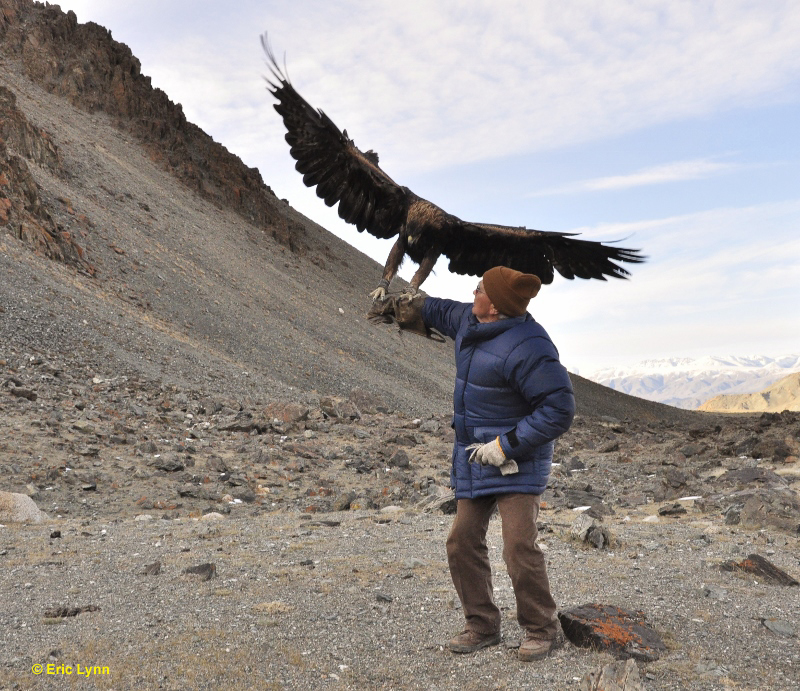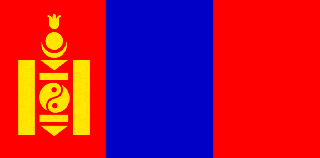
Mongolia - Land of Blue Skies
Mongolia is the 18th largest country in the world, land-locked and with a population of less than 3 million people. Yet, this country, about the size of Alaska, holds a fascinating history and contains some of the most incredeible landscapes to be found on the planet.
Why Mongolia?
I first read about the eagle hunters about 15 years ago. My experience in wildlife rescue, and more specifically with raptors, made me want to see these hunters and their birds and finally I decided to make the trip. I have always gravitated towards the wild parts of the planet so Mongolia had a draw I was looking forward to, and, I would get more ideas for my wildlife illustration work.
I went to Mongolia to experience the Annual Golden Eagle Festival held in Olgii, a remote city in the far west edge of Outer Mongolia and to see the Kazakh Eagle Hunters ( Berkutchis ) in action and I was not disappointed. Be advised that traveling to Outer Mongolia will not be a four-star trip, and in that is the joy of traveling and experiencing Outer Mongolia and the steppes.
.jpg)
Modern eagle hunters are nomadic peoples living in Central Asia, most notable are the Kazakhs and Kyrgyz. Kyrgyz nomads surrendered to Jochi Khan, Genghis' son in 1207. Under Mongol rule they were able to keep their falconry traditions up to the present. The Kazakhs are another nomadic tribe from central Asia who were also influence by the mongols of the Khan family. By the 18th century Kazakhs were immigrating into western China and Mongolia and bringing their customs and nomadic skills with them. During the Soviet occupation of Mongolia in the early 20th century, eagle hunting was banned, but, the skills were kept alive by some Kazakhs living in remote areas of Outer Mongolia.
Today, the eagle hunting tradition has been brought back to life slowly as more and more Kazakhs and Mongolians learn and practise the skills needed to hunt with Golden Eagles. In Kazakhstan, eagle hunting was banned by the soviets, but today it is also growing as more young Kazakhs set out to learn a tradition from their past.
The Golden Eagle Festival began in 1990 in the town of Olgii (Ulgii), a small town on the western edge of Mongolia. The first few festivals had a handful of hunters who participate in a series of hunting and time trials for the hunter and eagle. Today, over 70 participants show off their skills, their birds and their finest hunting clothes for the two-day event generally held at the end of September.
In 2017 there were over 70 hunters with their birds paticipating in the festival. Included in the line up was Aisholpan, the lead figure in the film The Eagle Huntress which was released in 2106. Aisholpan competed, along with several other young women alongside the men in what had traditionally been a man's sport and now open to both genders.
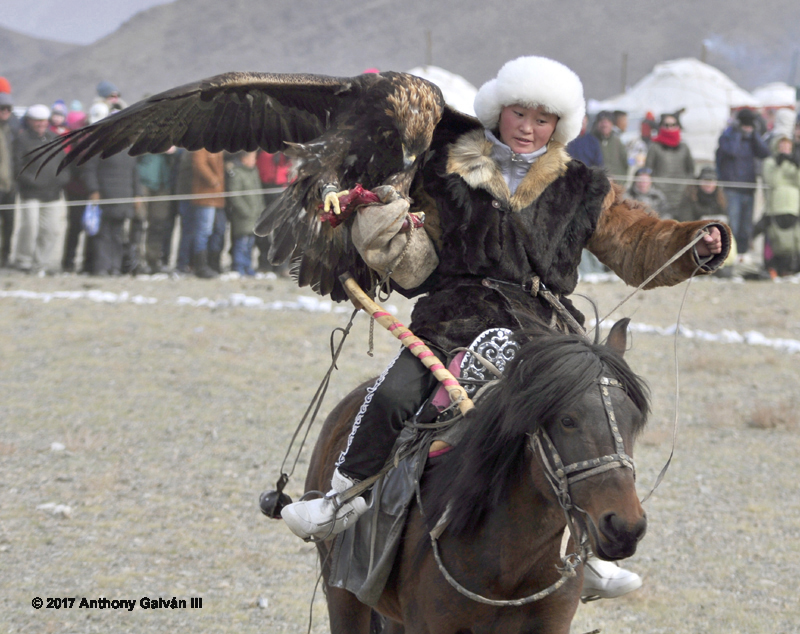
Aiosholpan with her eagle in the timed flight event.
The 2017 festival was held on September 30th and October lst outside the town of Olgii. Olgii is in the Bayan Province; 40+ miles from the Russian border, 50+ miles from the Kazakhstani border and 60+ miles from the Chinese border. The only safe way to reach Olgii is by air. The three hour flight from the capital city of Ulaanbataar can be quite an adventure in itself. The Olgii airport runway was recently paved but the airport does not have an instrument approach system in operation (as of 9/2017). This means it is a visual flight rules (VFR) airport and it is not uncommon to have flights cancelled at the last moment due to high winds or haboods, sand storms.
The simplicity of the airport and the hoops you may need to get through just to get to Olgii make the seeing the festival that much more special. Two airlines fly in and out of Olgii, Aero Mongolia and Mongolian Airlines (MIAT). Pack carefully and light because your baggage and carry on are treated as two separate items with a 15 kilo limit for each. If you go over the weight limit with each item you will be charged an overweight fee for each item.
“fast horses and fierce eagles are the wings of the Kazakh people,”
The Festival
First Day:
1. Timed release trial of the eagle from a mountain top to the hunter riding a horse. The goal is to see how quickly the eagle spots his handler and "mans" the glove.
.jpg)
%20(640x445).jpg)
2. Jambi atu - archery using the Mongolian recurve bow.
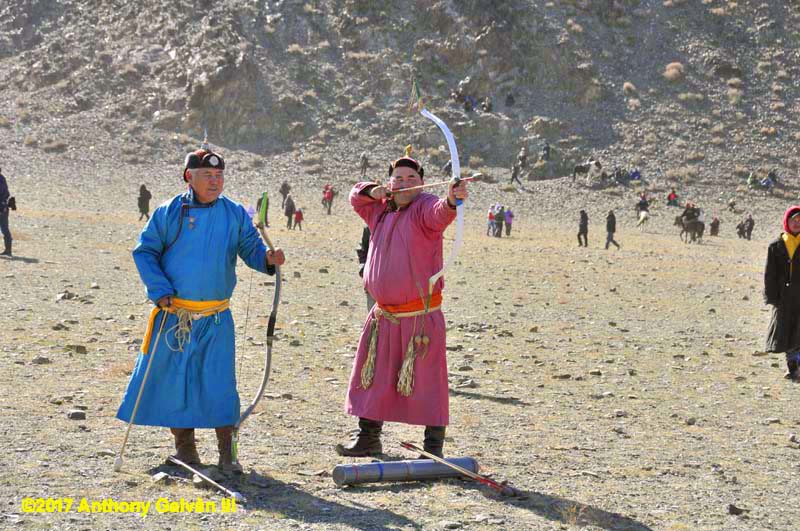
3. Camel race - the camels appeared out of no where, ran across the open field and then disappeared. These are Bactrian camels, with two humps and larger than the single hump Dromedary camel of the middle east; these camels move along a good pace and seem more placid than their desert cousins.

4. Tiyn Teru - a rider gallops to pick up four coins set on the ground on both left and right side of the horse. The coins are spaced about 20 meters apart, on the left and right of a riding line. The event is timed and the winner with the shortest time and most coins is the winner.
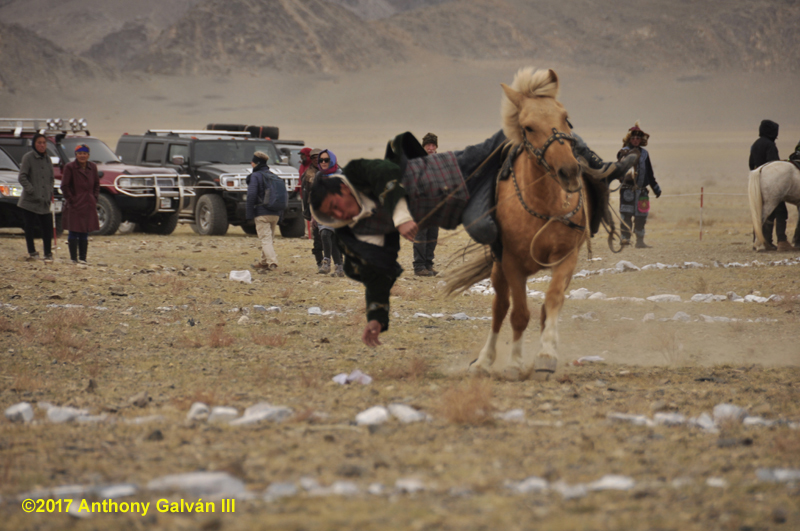
Second Day:
1. Shyrga Tartu (chasing the lure) - the eagle is timed to see how quickly it can spot a lure being dragged behind a horse and fly and capture the lure. Just before the bird is released the hunter will call it in hope of getting its attention. Sometimes the eagle sees the handler and stoops right towards the lure and other times it says to itself, " today seems like a nice day just to soar over the crowd" and off it goes enjoying the day's thermals over the playing field.
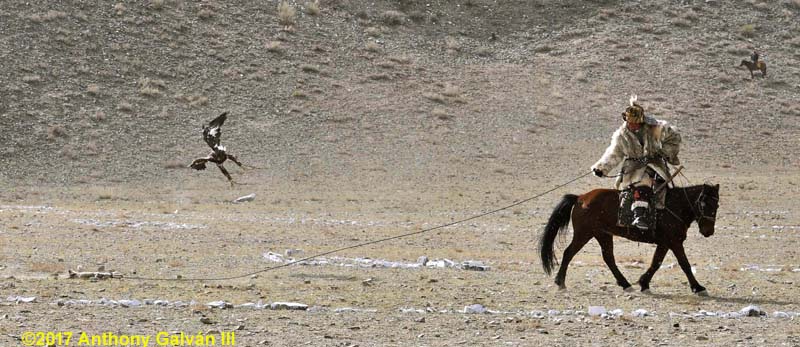
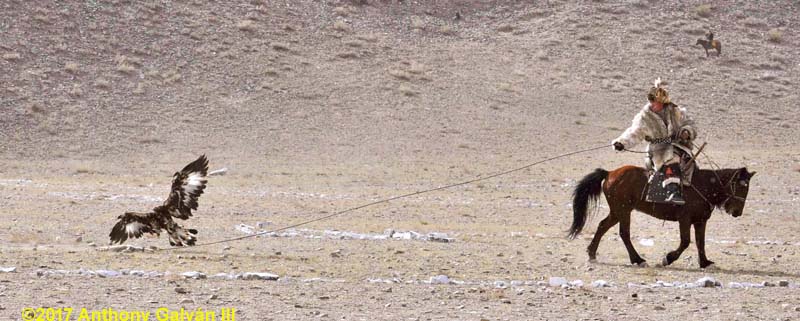
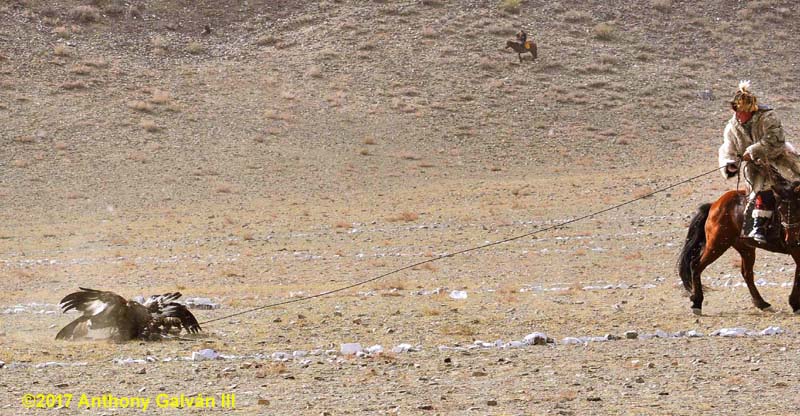
2. Costume parade. This is a colorful event with all manner of color and fabric on horse and camel.

3. Kyz Kuar - the whipping game. I was told that it started when a girl caught her boyfriend kissing another girl. She gave chase on horseback to whip him back into shape. The winner in this event is the woman who scores the most hits. This is a fun event and both contestants seem to enjoy the chase.
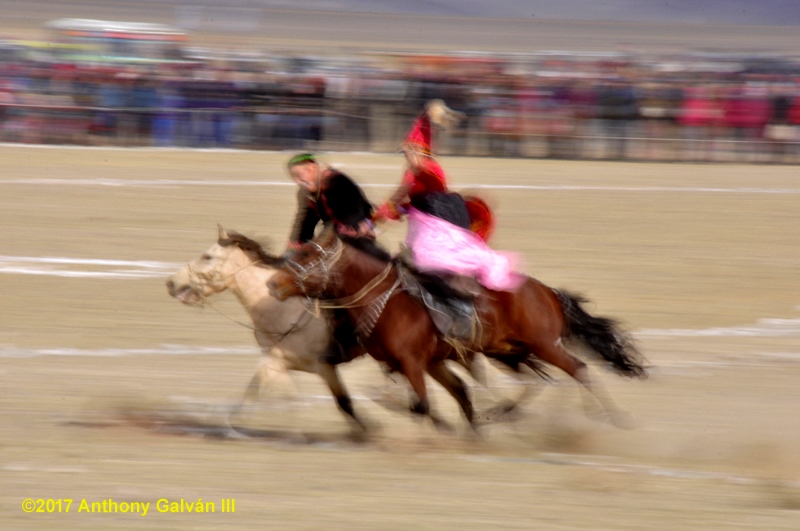
4. Kokbar, also known as bushkashi in Afganistan, is a tug of war event using a goat or fox pelt; the goal to place the goat skin over a goal. This event can get heated between the players and often involves festival officials and police stepping in to keep the peace on the field.
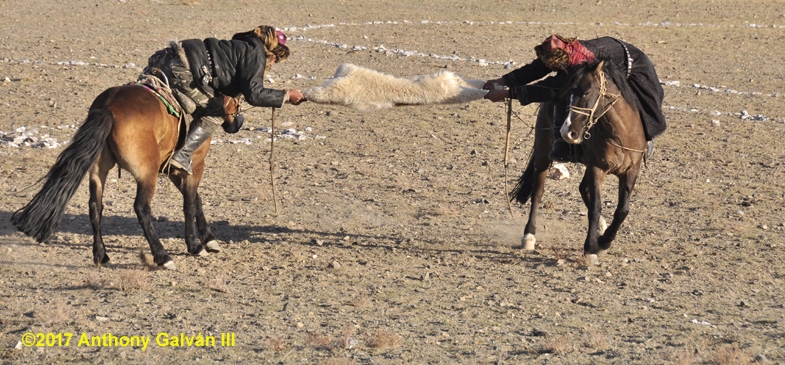
1st Day Photo Album - time trials: manning the glove and Tiyn Teru (fox skin grab), participants and archery
2nd Day Photo Album - costumes, Kyz Kuar (whipping race) and Kolpar (goat tug-of-war)
Mongolia - the Steppes & if you go
Getting to Mongolia from the U.S. is not difficult, but, it is a long trip. From Los Angeles (LAX) I took a flight to Seoul, Korea. I then took another flight to Ulaanbataar, the capital of Mongolia. Finally, to arrive in Olgii, the site of the festival, I took a domestic flight from Ulaanbaatar to Olgii. Total transit time from LAX to Ulaanbataar was 22 hours.
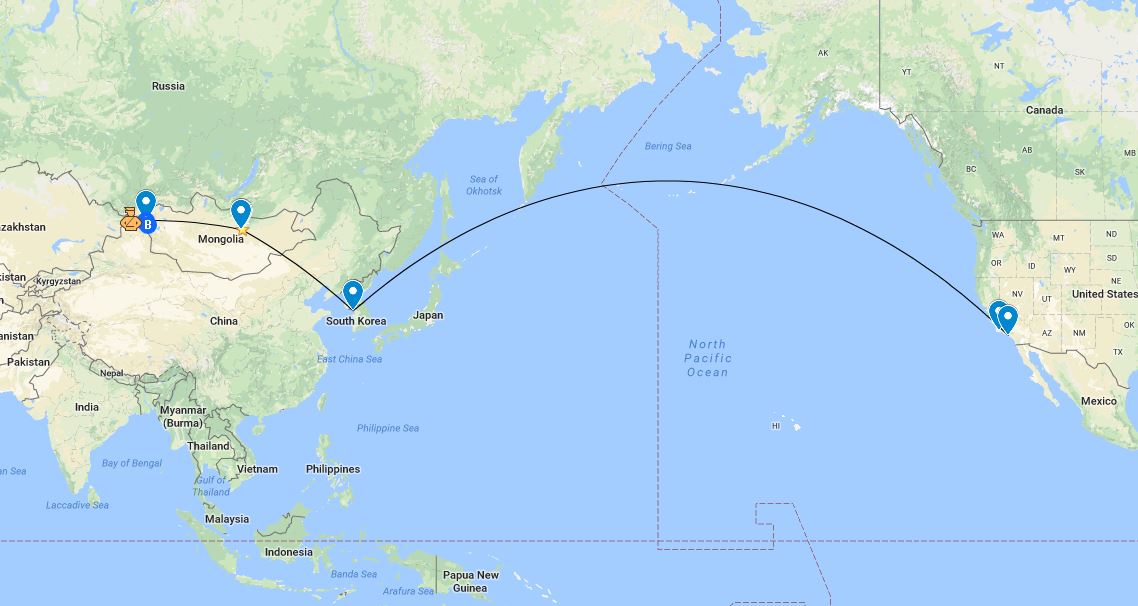
Ulaanbataar is a modern city with almost half of the country's population of 1.3 million people. International flights normally fly in from Korea, Beijing or Hong Kong. Getting to Olgii requires flying on one of two major domestic Mongolian airlines. I flew on Areo Mongolia from the capital to Olgii. Be flexible when flying to Olgii. The airport was recently paved but the airport is not an "all-weather" airport, as of September, 2017. Weather issues such as high winds and dust storms will cancel incoming and outgoing flights.
.jpg)
Gheghis Khan Sukbataar Square, Ulaanbataar.
.jpg)
Fokker F50 used by Aero Mongolia on domestic routes at the Olgii airport.
Olgii is the gateway to see and experience Kazakh culture. Despite a lack of many modern conveniences, the area thrives with incredible landscapes, changing weather and a location close to where four countries, Mongolia, Russia, China and Kazakhstan almost have a common border.

Mongolia has plenty of blue skys and lots of miles of miles and miles. Think Big Sky Montana and you get the picture of what you will find in Mongolia. Mongolians have a long history which includes creating the largest empire the world has seen in the 13th century under Gheghis Khan. The Mongol Empire stretched from eastern Europe to the Sea of Japan and was larger than the Roman Empire. History only highlights the violent and brutal side of the expansion of the empire, but under Gheghis Khan trade expanded, technology was traded and refined (gun powder and silk growing, to name two) and various forms of government and introduced across the face of the eastern hemisphere. Some methods and ideas were successful and others were not. Yet, the expansion of the Mongul Empire put to rest that Europe was the center of the world.
Present day Mongolia, a former soviet satellite, became an independent country in 1992. Ulaanbataar is a modern city yet outside the capital one will still find nomadic peoples keeping their herding and cultural traditions very much alive. I discovered that some customs and habits practised by nomadic Mongolians are similar to those of cultures and peoples I am familiar with in the Americas. Gers (Mongolian) or Yurts (Turkic) are similar in design to Navajo hogans, Hogans, however, are permanant structures while the ger or yurt is meant to be portable. They are round, have a center smoke hole and like the hogan, the door is always oriented to the east to greet the morning sun.
Mongolians practise buddishm or shamanism and Kazakhs practise Islam. Horsemanship and archery are central to the Mongolian and it should come as no surprise since the domestication of the horse was probably started on the Eurasion steppes around 3500 bce. Archery was central in the success of the Mongolian Empire and the Golden Hordes conquest all the way to Rome. The Mongolians gave us the recurve bow, which was used sucessfully by later cultures in throughout Eurasia.
Mongolia is wide open spaces, blue skys, snow capped mountains in the west and desert regions to the south. Situated south of present day Russian, forested areas are found in the northern areas of Mongolia.
.jpg)
Our ger camp south of Tolbo, Olgii-Bayan
.jpg)
Ger camp. The two small boxes are the restroom facilities, a simple slit trench.
While modern amenities at camp were minimal the gers were kept warm with a wood burning stove. There is no running water but a dining ger provided all the essentials to stay warm and eat and drink as much as one wanted. Goat, mutton, beef, potatos and onions were the normal evening fare. Beer and vodka were always handy, along with tea and coffee, for those thirsty after each day. I found the silence rewarding as well as not seeing an airplane or contrail in the sky for the three days I was in the steppes. If you need more modern conveniences then this type of tour may not be your cup of tea.
The elevation of the camp was around 7,000 feet above sea level. The temperatures ranged between 25 to 35 degree fahrenheit and we were treated to snow flurries off and on as well as a habood (sand storm) and the vistas every day were incredible.
.jpg)
Tsambagarav Mountain range in the background, grassy steppes below the 13,000+ foot range and a sheltered place to graze sheep and cattle. Olgii is roughly 30 miles north.
Steppe Photo Album - the country side from Olgii to Tolbo.
The Eagle Hunter
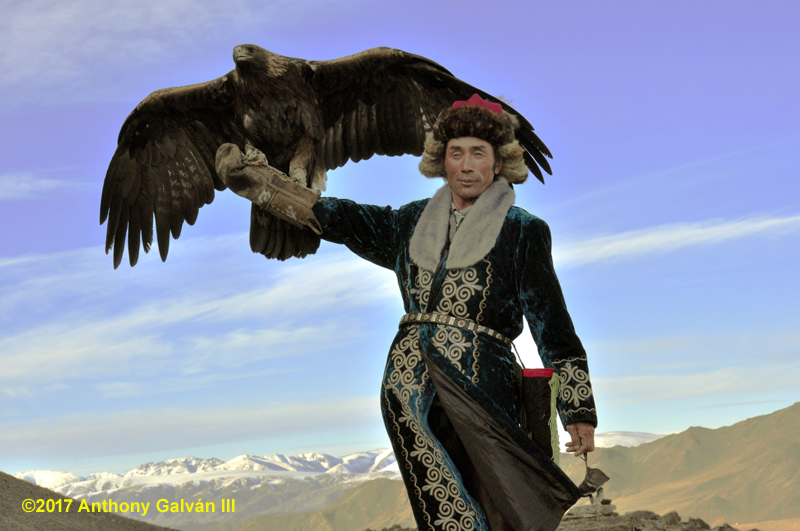
Beken Ermyekbai, a third generation eagle hunter and the top hunter in the Tolbo area.
The opportunity to take part in a Kazakh Eagle Hunt was something I had hope to experience in Mongolia and I was able to do so.
If hunting is an activity you do not support or agree with keep in mind that the Kazakh Eagle Hunting tradition has been recognized by UNESCO as a World Cultural Event, which means it is an activity worth saving. While diversity is the current PC buzz word it is important to remember that culture and heritage provides all communities and groups a source of identity, be it hunting, monster car rallies or flash mob danding. A cultural event provides a way for all of us on this planet to recognize the fact that we are not singular entities but part of a greater group, each with distinct traits, skills, like and dislikes. With this in mind I hope you will appreciate the skills and traditions of hunting with eagles in Mongolia.
Hunting with birds of prey is known as falconry though the birds used are not always falcons. The Kazakh hunters train Golden Eagles, Aquila chrysaetos, one of the largest birds of prey on the planet. Eurasian Golden Eagles often have wings spans of over six feet and may weigh up to 17 pounds or more. The Golden Eagle is found through in Asia, North America, Africa and Europe.
In Medival Europe only a king could hunt with a Golden Eagle or a Gyr Falcon. The pecking order in what bird you could hunt with was based on your rank or title. Small birds such as Kestrels were relegated to knaves, servants and children. For the Kazakh, though, rank is not a factor in hunting with an eagle, but rather the time consuming period of looking for a bird and training it to ride with the hunter on horseback and then find the prey, a fox, wolf or hare.
Falconry terms have changed little from medieval times and some have evolved into English terms and phrases used everyday with little to do with falconry. Here are a few falconry terms which have crept into modern English. The Kazakhs have refined the equipment they use over time and much of it does not resemble what western falconers use or make. The differences in equipment is what makes seeing the Kazakh eagle hunter work in the field different and rewarding.
The word codger, used today to describe an old man, can be traced back to the falconry term cadger, or a person who carried a portable perch called a cadge for the falconer. Most cadgers were retired falconers and in time a corruption of this came to be used for an old man. When raptors
drink it is called bowsing and a bird that drinks heavily is called a boozer,
the term used to describe the same tendency in humans.
The term mantle piece comes from the actions raptors make when covering and protecting their kill, mantling or to mantle the kill. Hoodwinked, was the action of placing a hood over the falcon's head to recover the captured prey from the falcon's talons; pretty much the same as now when you are cheated out something. Getting a bird to rest on the glove is called manning the glove. Raptors are kept in mews. In London you can visit the Queen's Mews, though there are no raptors there at present. The straps around a bird's ankles are called jesses. Raptors do not have claws, they have talons. Raptors do not dive, they stoop. Eagle hunters man their birds on their right hand. Western falconers man their birds on the left hand though I did see a couple manning with the left.
|
|---|


